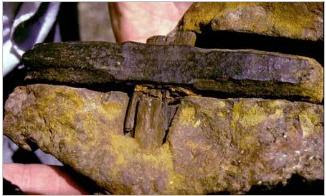Occasionally, archaeologists come across finds which are "out of time" - that is, they do not fall in line with our current history books.
1.Pre-Historic Aeroplanes from South America

These objects shown in the photographs above have caused controversy.
Some believe that they are nothing more than highly ornate, stylised sculptures of flying insects, others believe that the objects are depictions of flying aircraft.
Why the controversy?
These artefacts, two inches long, made from gold, found in Peru are estimated to be 800 - 1000 years old!
Classified as “Sinu” a pre-Inca culture
The controversy was so great that in 1997, a prototype of the exact (scaled-up) shape of the object was re-created, a propeller and engine added, and it was proved to be an effective flying machine.
2.Micro-fine Russian Metal Screws

The objects photographed above were discovered by gold prospectors, between 1991 and 1993 in numerous sites along the river Narada in Russia.
They are spiral in shape and range in size from 0.003mm to 3cm.
They are made from various metals - copper, tungsten and molybdenum.
Tungsten and molybdenum have high melting points (6100 deg F and 4750 deg F) and are primarily used today for highly stressed weapon parts and vehicle armour.
Tests upon the objects date them at between 20,000 and 318,000 years old!
The burning question therefore is who made them, are what they were for?
3.The Piri Reis Map

The map shown above was drawn out on Gazelle skin by Piri Reis, a famous Admiral of the Turkish fleet in 1513.
He used information from the Imperial Library of Constantinople from information he found which dated back to 4000 BC.
What makes this map remarkable is that it accurately depicts the entire Antarctic region before it was covered in ice.
Something that modern day cartography only managed to do (from above the ice) in 1949.
Scientists have various predictions in respect of the last time that the Antarctic was without ice - the earliest prediction is 4000 BC - the latest 13000 BC.
So which civilisation between 13000 BC and 4000 BC were capable of such detailed cartography!
Modern cartographers have also commented that to compile such a detailed and accurate map, information would have had to have been taken from an aerial view - which only serves to deepen the mystery.
4.Mexican Dinosaur Statues

These statues pictured above, along with 33,000 other similar ones (all of varied but known dinosaur species) were discovered in 1945 during an archaeological dig in Acambaro, Mexico.
They are thought to have been made by the Chupicuaro Culture who lived in this region of Mexico between 800 and 200 BC.
Yet archaeologists assert that dinosaurs became extinct around 65 million years ago and that mans knowledge of them is limited to the last 200 years.
5.The Kingoodie Hammer

The object pictured above is believed to be a hammer, made of nailed iron and wood.
It was discovered in 1844 in the Kingoodie quarry in Scotland, within a slab of red sandstone.
This all sounds very ordinary until it is explained that the sandstone encasing the hammer has been studied and dated by geologists, and is known to be between 360 and 408 million years old.
To get some measure of the enormity of this find, homo sapiens are said to have evolved just 400 thousand years ago.



















 The water is rising in Kazan... streets are turning into rivers -
The water is rising in Kazan... streets are turning into rivers -



 But if the road is still there and simply flooded, then -
But if the road is still there and simply flooded, then -





 Trucks are invincible, or so it seems:
Trucks are invincible, or so it seems:




 Well then, If I just push it...
Well then, If I just push it...
 This guy is still trying to steer:
This guy is still trying to steer:

 Nearby, the tornado (waterspout) threatens the oil refinery:
Nearby, the tornado (waterspout) threatens the oil refinery:
 Some cars don't need a wide-spread flood to get in trouble। It just happens to them -
Some cars don't need a wide-spread flood to get in trouble। It just happens to them -
 Kids make the most out of flooded roads (picture taken during recent flooding in Jakarta) -
Kids make the most out of flooded roads (picture taken during recent flooding in Jakarta) -
